NURSING DOCUMENTATION: Self-Reflection using Gibbs' Cycle Model
VerifiedAdded on 2022/09/01
|11
|2435
|34
Essay
AI Summary
This essay presents a graduate nurse's reflection on nursing documentation, highlighting its importance in patient care, legal aspects, and reimbursement. The reflection covers the nurse's responsibilities in maintaining accurate and accessible records, ensuring compliance with healthcare standards, and contributing to evidence-based practice. It addresses challenges in documentation quality, including inconsistencies and errors, and proposes strategies for improvement, such as engaging nurses in decision-making, providing comprehensive training, and promoting access to health records for patients. The essay also emphasizes the role of electronic health records in enhancing efficiency and the need for standardized nursing language. The reflection employs Gibbs' Reflective Cycle, analyzing personal experiences and suggesting actionable steps to enhance documentation practices and improve patient outcomes. This document is available on Desklib, a platform providing AI-powered study tools and resources for students.
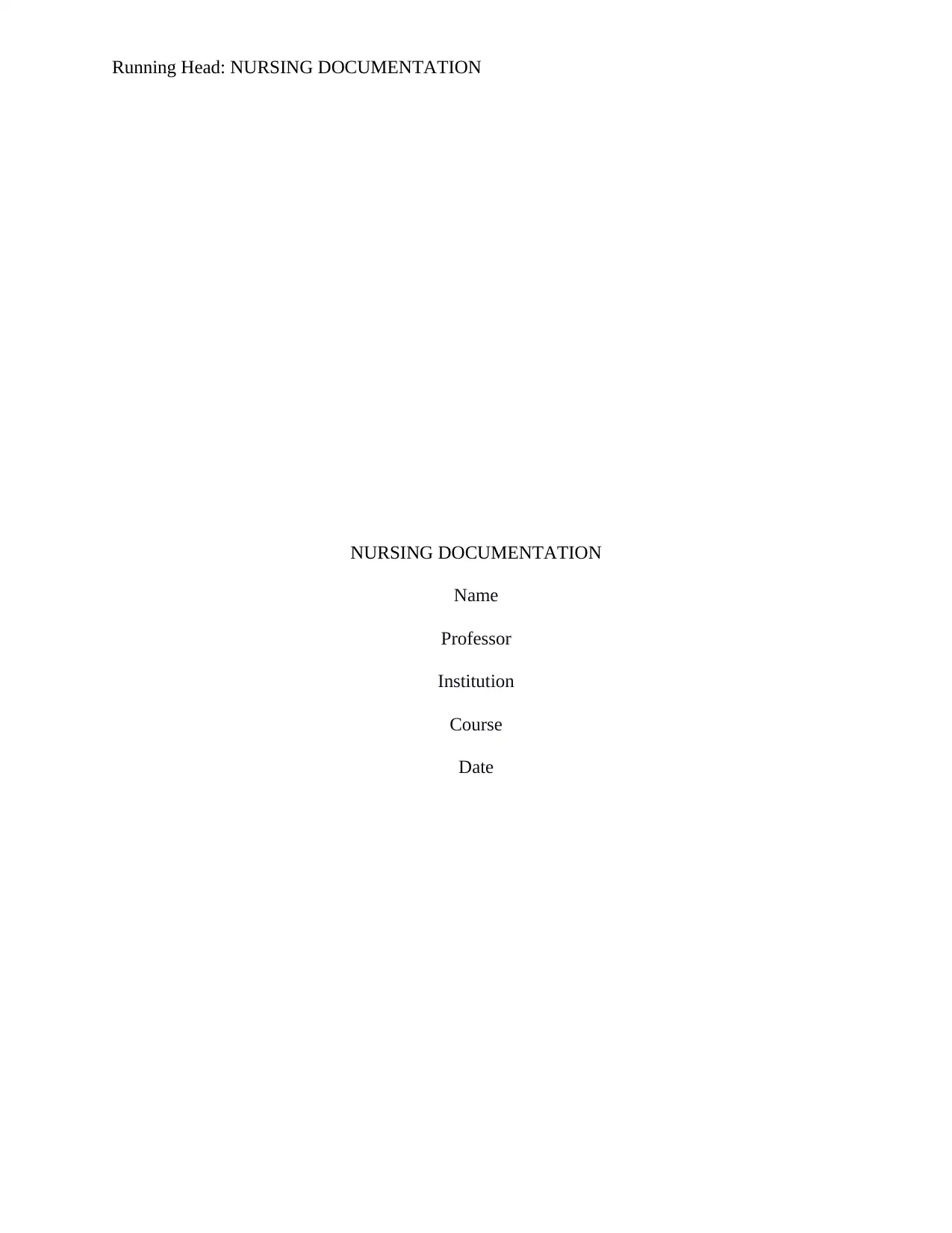
Running Head: NURSING DOCUMENTATION
NURSING DOCUMENTATION
Name
Professor
Institution
Course
Date
NURSING DOCUMENTATION
Name
Professor
Institution
Course
Date
Paraphrase This Document
Need a fresh take? Get an instant paraphrase of this document with our AI Paraphraser
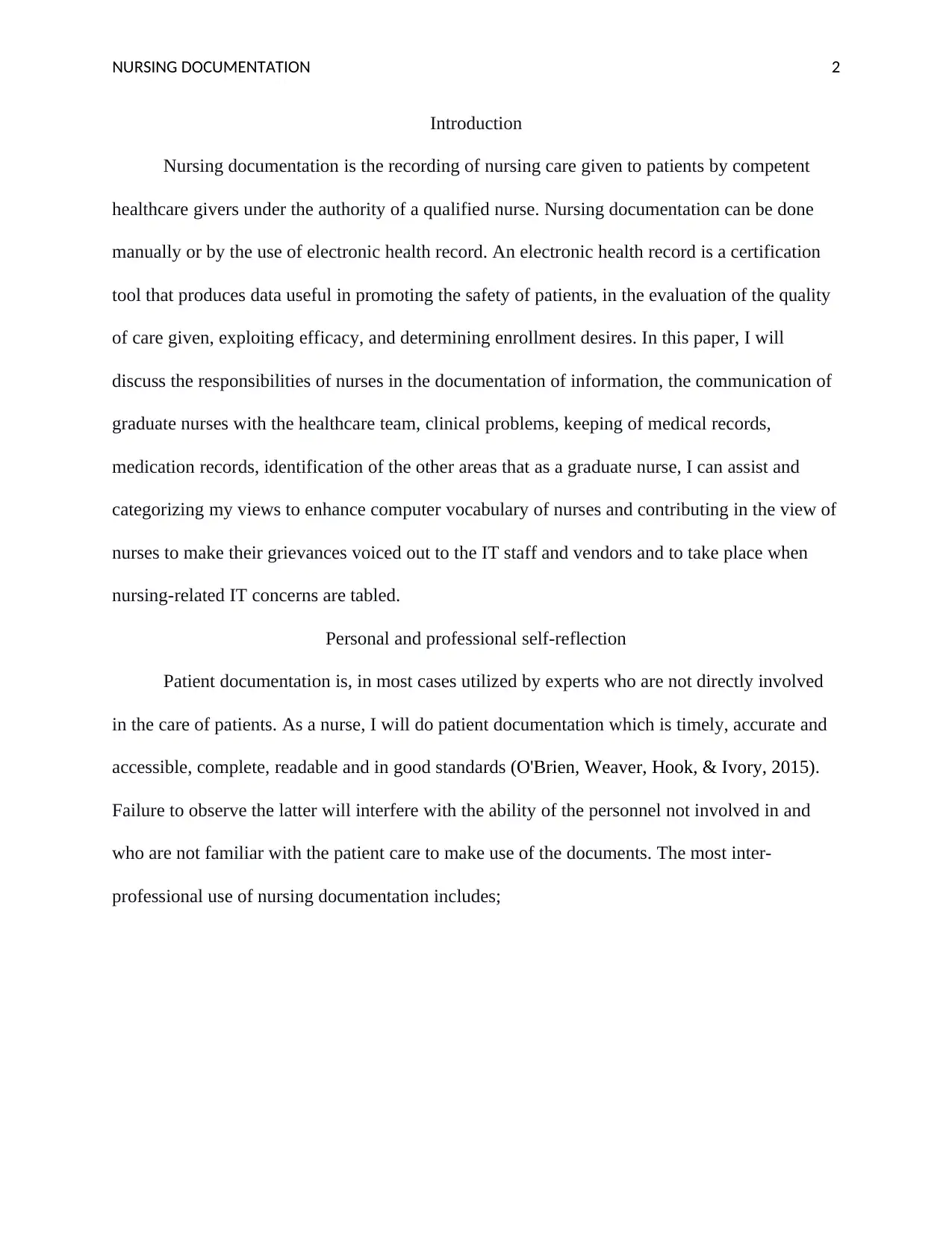
NURSING DOCUMENTATION 2
Introduction
Nursing documentation is the recording of nursing care given to patients by competent
healthcare givers under the authority of a qualified nurse. Nursing documentation can be done
manually or by the use of electronic health record. An electronic health record is a certification
tool that produces data useful in promoting the safety of patients, in the evaluation of the quality
of care given, exploiting efficacy, and determining enrollment desires. In this paper, I will
discuss the responsibilities of nurses in the documentation of information, the communication of
graduate nurses with the healthcare team, clinical problems, keeping of medical records,
medication records, identification of the other areas that as a graduate nurse, I can assist and
categorizing my views to enhance computer vocabulary of nurses and contributing in the view of
nurses to make their grievances voiced out to the IT staff and vendors and to take place when
nursing-related IT concerns are tabled.
Personal and professional self-reflection
Patient documentation is, in most cases utilized by experts who are not directly involved
in the care of patients. As a nurse, I will do patient documentation which is timely, accurate and
accessible, complete, readable and in good standards (O'Brien, Weaver, Hook, & Ivory, 2015).
Failure to observe the latter will interfere with the ability of the personnel not involved in and
who are not familiar with the patient care to make use of the documents. The most inter-
professional use of nursing documentation includes;
Introduction
Nursing documentation is the recording of nursing care given to patients by competent
healthcare givers under the authority of a qualified nurse. Nursing documentation can be done
manually or by the use of electronic health record. An electronic health record is a certification
tool that produces data useful in promoting the safety of patients, in the evaluation of the quality
of care given, exploiting efficacy, and determining enrollment desires. In this paper, I will
discuss the responsibilities of nurses in the documentation of information, the communication of
graduate nurses with the healthcare team, clinical problems, keeping of medical records,
medication records, identification of the other areas that as a graduate nurse, I can assist and
categorizing my views to enhance computer vocabulary of nurses and contributing in the view of
nurses to make their grievances voiced out to the IT staff and vendors and to take place when
nursing-related IT concerns are tabled.
Personal and professional self-reflection
Patient documentation is, in most cases utilized by experts who are not directly involved
in the care of patients. As a nurse, I will do patient documentation which is timely, accurate and
accessible, complete, readable and in good standards (O'Brien, Weaver, Hook, & Ivory, 2015).
Failure to observe the latter will interfere with the ability of the personnel not involved in and
who are not familiar with the patient care to make use of the documents. The most inter-
professional use of nursing documentation includes;
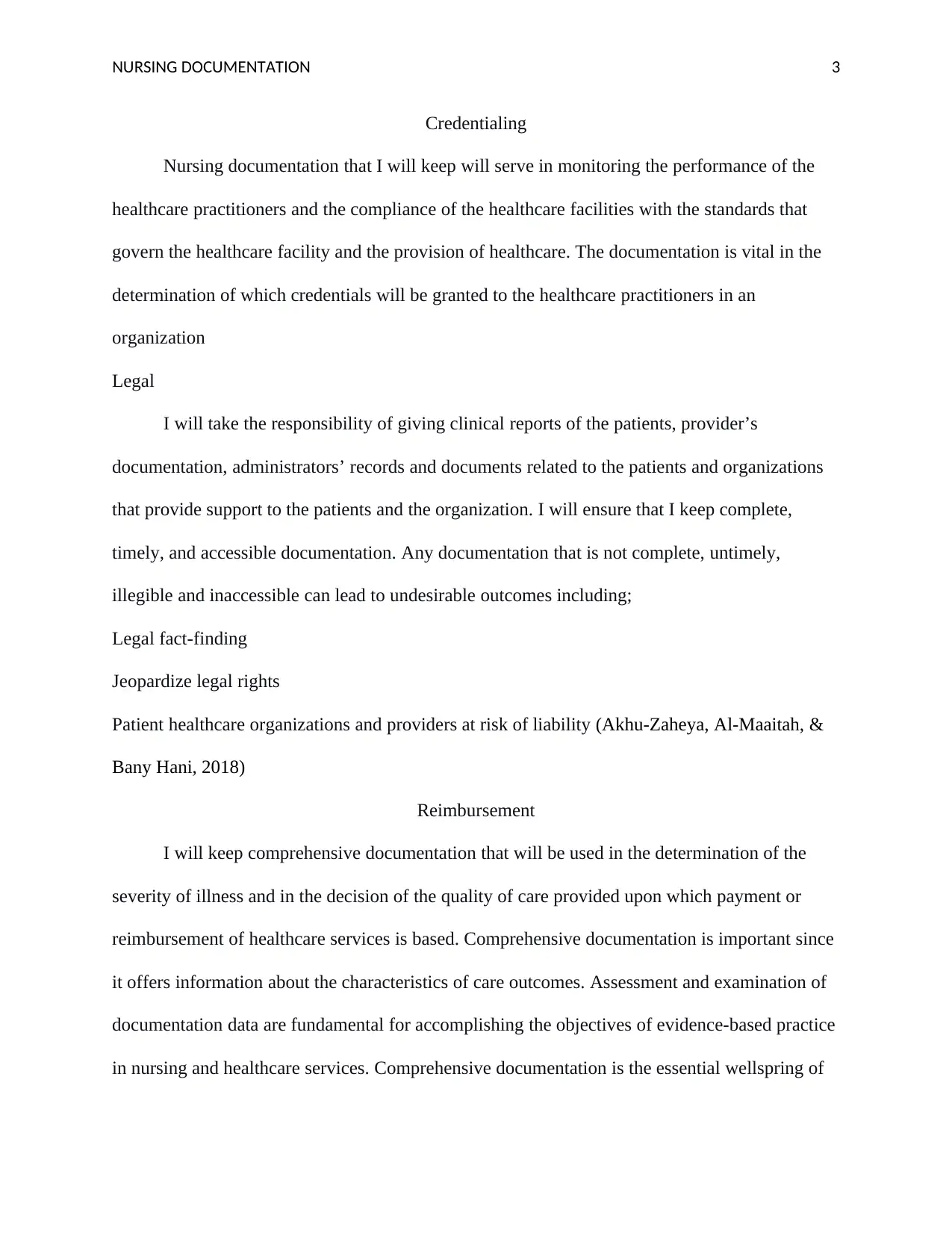
NURSING DOCUMENTATION 3
Credentialing
Nursing documentation that I will keep will serve in monitoring the performance of the
healthcare practitioners and the compliance of the healthcare facilities with the standards that
govern the healthcare facility and the provision of healthcare. The documentation is vital in the
determination of which credentials will be granted to the healthcare practitioners in an
organization
Legal
I will take the responsibility of giving clinical reports of the patients, provider’s
documentation, administrators’ records and documents related to the patients and organizations
that provide support to the patients and the organization. I will ensure that I keep complete,
timely, and accessible documentation. Any documentation that is not complete, untimely,
illegible and inaccessible can lead to undesirable outcomes including;
Legal fact-finding
Jeopardize legal rights
Patient healthcare organizations and providers at risk of liability (Akhu‐Zaheya, Al‐Maaitah, &
Bany Hani, 2018)
Reimbursement
I will keep comprehensive documentation that will be used in the determination of the
severity of illness and in the decision of the quality of care provided upon which payment or
reimbursement of healthcare services is based. Comprehensive documentation is important since
it offers information about the characteristics of care outcomes. Assessment and examination of
documentation data are fundamental for accomplishing the objectives of evidence-based practice
in nursing and healthcare services. Comprehensive documentation is the essential wellspring of
Credentialing
Nursing documentation that I will keep will serve in monitoring the performance of the
healthcare practitioners and the compliance of the healthcare facilities with the standards that
govern the healthcare facility and the provision of healthcare. The documentation is vital in the
determination of which credentials will be granted to the healthcare practitioners in an
organization
Legal
I will take the responsibility of giving clinical reports of the patients, provider’s
documentation, administrators’ records and documents related to the patients and organizations
that provide support to the patients and the organization. I will ensure that I keep complete,
timely, and accessible documentation. Any documentation that is not complete, untimely,
illegible and inaccessible can lead to undesirable outcomes including;
Legal fact-finding
Jeopardize legal rights
Patient healthcare organizations and providers at risk of liability (Akhu‐Zaheya, Al‐Maaitah, &
Bany Hani, 2018)
Reimbursement
I will keep comprehensive documentation that will be used in the determination of the
severity of illness and in the decision of the quality of care provided upon which payment or
reimbursement of healthcare services is based. Comprehensive documentation is important since
it offers information about the characteristics of care outcomes. Assessment and examination of
documentation data are fundamental for accomplishing the objectives of evidence-based practice
in nursing and healthcare services. Comprehensive documentation is the essential wellspring of
⊘ This is a preview!⊘
Do you want full access?
Subscribe today to unlock all pages.

Trusted by 1+ million students worldwide
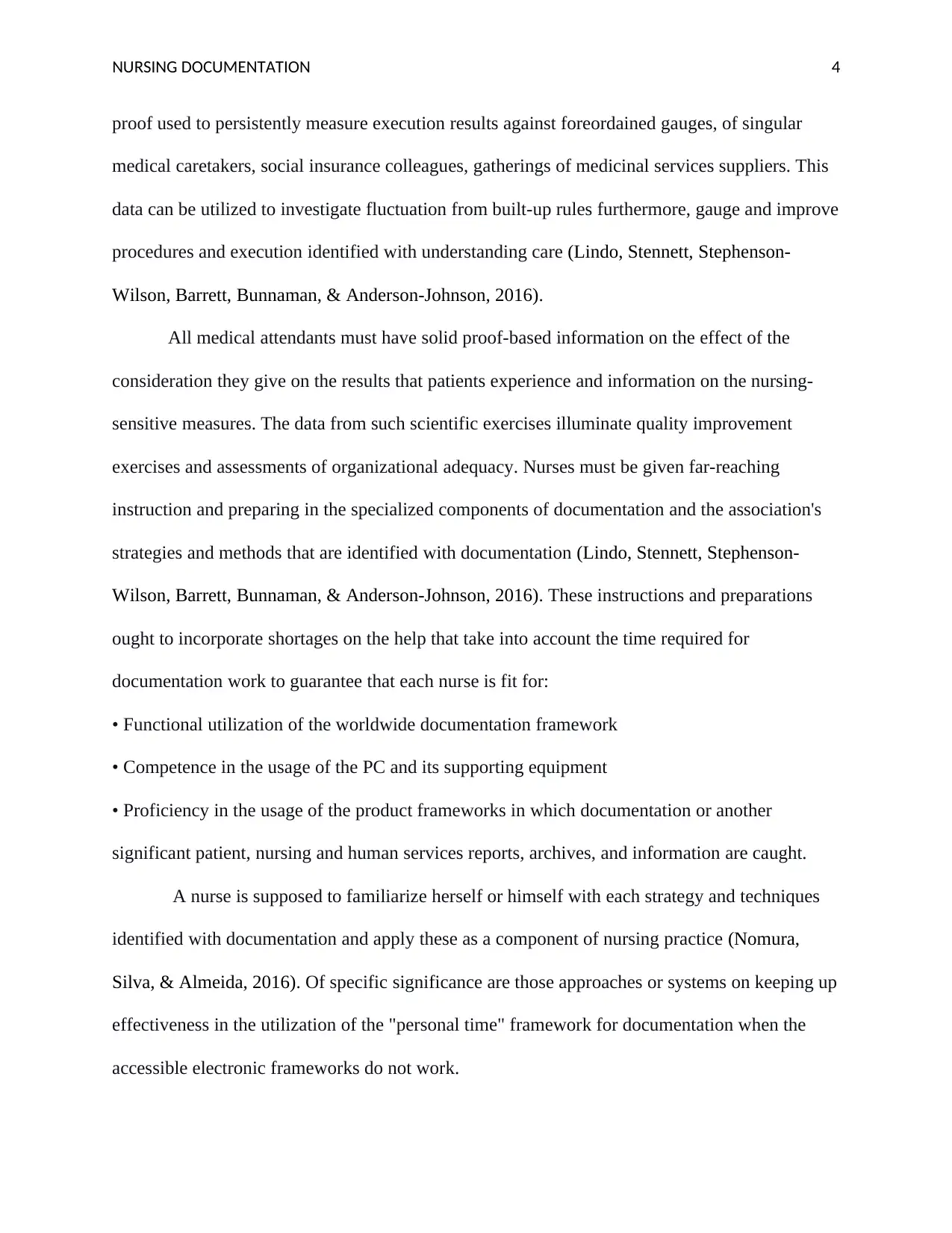
NURSING DOCUMENTATION 4
proof used to persistently measure execution results against foreordained gauges, of singular
medical caretakers, social insurance colleagues, gatherings of medicinal services suppliers. This
data can be utilized to investigate fluctuation from built-up rules furthermore, gauge and improve
procedures and execution identified with understanding care (Lindo, Stennett, Stephenson‐
Wilson, Barrett, Bunnaman, & Anderson‐Johnson, 2016).
All medical attendants must have solid proof-based information on the effect of the
consideration they give on the results that patients experience and information on the nursing-
sensitive measures. The data from such scientific exercises illuminate quality improvement
exercises and assessments of organizational adequacy. Nurses must be given far-reaching
instruction and preparing in the specialized components of documentation and the association's
strategies and methods that are identified with documentation (Lindo, Stennett, Stephenson‐
Wilson, Barrett, Bunnaman, & Anderson‐Johnson, 2016). These instructions and preparations
ought to incorporate shortages on the help that take into account the time required for
documentation work to guarantee that each nurse is fit for:
• Functional utilization of the worldwide documentation framework
• Competence in the usage of the PC and its supporting equipment
• Proficiency in the usage of the product frameworks in which documentation or another
significant patient, nursing and human services reports, archives, and information are caught.
A nurse is supposed to familiarize herself or himself with each strategy and techniques
identified with documentation and apply these as a component of nursing practice (Nomura,
Silva, & Almeida, 2016). Of specific significance are those approaches or systems on keeping up
effectiveness in the utilization of the "personal time" framework for documentation when the
accessible electronic frameworks do not work.
proof used to persistently measure execution results against foreordained gauges, of singular
medical caretakers, social insurance colleagues, gatherings of medicinal services suppliers. This
data can be utilized to investigate fluctuation from built-up rules furthermore, gauge and improve
procedures and execution identified with understanding care (Lindo, Stennett, Stephenson‐
Wilson, Barrett, Bunnaman, & Anderson‐Johnson, 2016).
All medical attendants must have solid proof-based information on the effect of the
consideration they give on the results that patients experience and information on the nursing-
sensitive measures. The data from such scientific exercises illuminate quality improvement
exercises and assessments of organizational adequacy. Nurses must be given far-reaching
instruction and preparing in the specialized components of documentation and the association's
strategies and methods that are identified with documentation (Lindo, Stennett, Stephenson‐
Wilson, Barrett, Bunnaman, & Anderson‐Johnson, 2016). These instructions and preparations
ought to incorporate shortages on the help that take into account the time required for
documentation work to guarantee that each nurse is fit for:
• Functional utilization of the worldwide documentation framework
• Competence in the usage of the PC and its supporting equipment
• Proficiency in the usage of the product frameworks in which documentation or another
significant patient, nursing and human services reports, archives, and information are caught.
A nurse is supposed to familiarize herself or himself with each strategy and techniques
identified with documentation and apply these as a component of nursing practice (Nomura,
Silva, & Almeida, 2016). Of specific significance are those approaches or systems on keeping up
effectiveness in the utilization of the "personal time" framework for documentation when the
accessible electronic frameworks do not work.
Paraphrase This Document
Need a fresh take? Get an instant paraphrase of this document with our AI Paraphraser
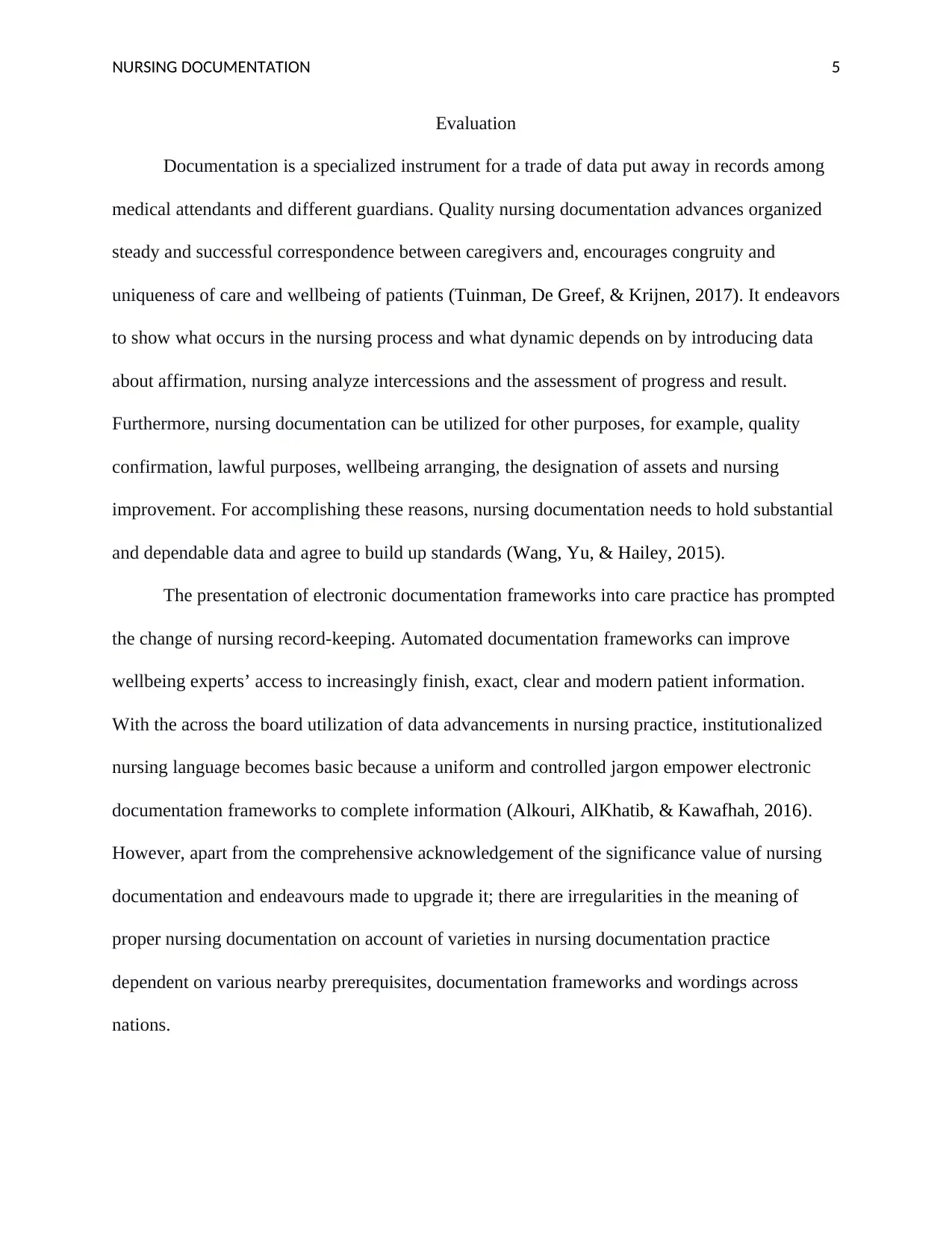
NURSING DOCUMENTATION 5
Evaluation
Documentation is a specialized instrument for a trade of data put away in records among
medical attendants and different guardians. Quality nursing documentation advances organized
steady and successful correspondence between caregivers and, encourages congruity and
uniqueness of care and wellbeing of patients (Tuinman, De Greef, & Krijnen, 2017). It endeavors
to show what occurs in the nursing process and what dynamic depends on by introducing data
about affirmation, nursing analyze intercessions and the assessment of progress and result.
Furthermore, nursing documentation can be utilized for other purposes, for example, quality
confirmation, lawful purposes, wellbeing arranging, the designation of assets and nursing
improvement. For accomplishing these reasons, nursing documentation needs to hold substantial
and dependable data and agree to build up standards (Wang, Yu, & Hailey, 2015).
The presentation of electronic documentation frameworks into care practice has prompted
the change of nursing record-keeping. Automated documentation frameworks can improve
wellbeing experts’ access to increasingly finish, exact, clear and modern patient information.
With the across the board utilization of data advancements in nursing practice, institutionalized
nursing language becomes basic because a uniform and controlled jargon empower electronic
documentation frameworks to complete information (Alkouri, AlKhatib, & Kawafhah, 2016).
However, apart from the comprehensive acknowledgement of the significance value of nursing
documentation and endeavours made to upgrade it; there are irregularities in the meaning of
proper nursing documentation on account of varieties in nursing documentation practice
dependent on various nearby prerequisites, documentation frameworks and wordings across
nations.
Evaluation
Documentation is a specialized instrument for a trade of data put away in records among
medical attendants and different guardians. Quality nursing documentation advances organized
steady and successful correspondence between caregivers and, encourages congruity and
uniqueness of care and wellbeing of patients (Tuinman, De Greef, & Krijnen, 2017). It endeavors
to show what occurs in the nursing process and what dynamic depends on by introducing data
about affirmation, nursing analyze intercessions and the assessment of progress and result.
Furthermore, nursing documentation can be utilized for other purposes, for example, quality
confirmation, lawful purposes, wellbeing arranging, the designation of assets and nursing
improvement. For accomplishing these reasons, nursing documentation needs to hold substantial
and dependable data and agree to build up standards (Wang, Yu, & Hailey, 2015).
The presentation of electronic documentation frameworks into care practice has prompted
the change of nursing record-keeping. Automated documentation frameworks can improve
wellbeing experts’ access to increasingly finish, exact, clear and modern patient information.
With the across the board utilization of data advancements in nursing practice, institutionalized
nursing language becomes basic because a uniform and controlled jargon empower electronic
documentation frameworks to complete information (Alkouri, AlKhatib, & Kawafhah, 2016).
However, apart from the comprehensive acknowledgement of the significance value of nursing
documentation and endeavours made to upgrade it; there are irregularities in the meaning of
proper nursing documentation on account of varieties in nursing documentation practice
dependent on various nearby prerequisites, documentation frameworks and wordings across
nations.
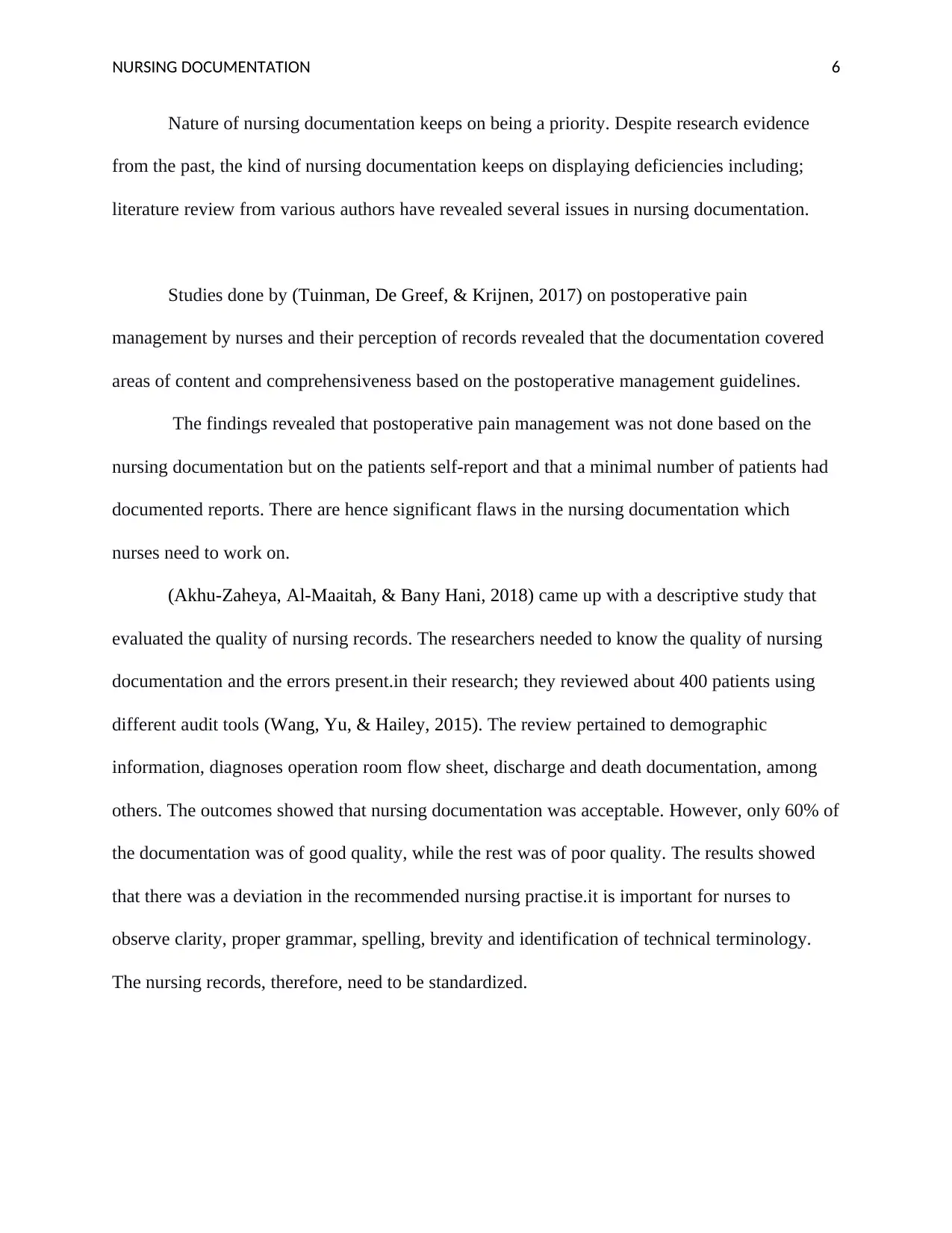
NURSING DOCUMENTATION 6
Nature of nursing documentation keeps on being a priority. Despite research evidence
from the past, the kind of nursing documentation keeps on displaying deficiencies including;
literature review from various authors have revealed several issues in nursing documentation.
Studies done by (Tuinman, De Greef, & Krijnen, 2017) on postoperative pain
management by nurses and their perception of records revealed that the documentation covered
areas of content and comprehensiveness based on the postoperative management guidelines.
The findings revealed that postoperative pain management was not done based on the
nursing documentation but on the patients self-report and that a minimal number of patients had
documented reports. There are hence significant flaws in the nursing documentation which
nurses need to work on.
(Akhu‐Zaheya, Al‐Maaitah, & Bany Hani, 2018) came up with a descriptive study that
evaluated the quality of nursing records. The researchers needed to know the quality of nursing
documentation and the errors present.in their research; they reviewed about 400 patients using
different audit tools (Wang, Yu, & Hailey, 2015). The review pertained to demographic
information, diagnoses operation room flow sheet, discharge and death documentation, among
others. The outcomes showed that nursing documentation was acceptable. However, only 60% of
the documentation was of good quality, while the rest was of poor quality. The results showed
that there was a deviation in the recommended nursing practise.it is important for nurses to
observe clarity, proper grammar, spelling, brevity and identification of technical terminology.
The nursing records, therefore, need to be standardized.
Nature of nursing documentation keeps on being a priority. Despite research evidence
from the past, the kind of nursing documentation keeps on displaying deficiencies including;
literature review from various authors have revealed several issues in nursing documentation.
Studies done by (Tuinman, De Greef, & Krijnen, 2017) on postoperative pain
management by nurses and their perception of records revealed that the documentation covered
areas of content and comprehensiveness based on the postoperative management guidelines.
The findings revealed that postoperative pain management was not done based on the
nursing documentation but on the patients self-report and that a minimal number of patients had
documented reports. There are hence significant flaws in the nursing documentation which
nurses need to work on.
(Akhu‐Zaheya, Al‐Maaitah, & Bany Hani, 2018) came up with a descriptive study that
evaluated the quality of nursing records. The researchers needed to know the quality of nursing
documentation and the errors present.in their research; they reviewed about 400 patients using
different audit tools (Wang, Yu, & Hailey, 2015). The review pertained to demographic
information, diagnoses operation room flow sheet, discharge and death documentation, among
others. The outcomes showed that nursing documentation was acceptable. However, only 60% of
the documentation was of good quality, while the rest was of poor quality. The results showed
that there was a deviation in the recommended nursing practise.it is important for nurses to
observe clarity, proper grammar, spelling, brevity and identification of technical terminology.
The nursing records, therefore, need to be standardized.
⊘ This is a preview!⊘
Do you want full access?
Subscribe today to unlock all pages.

Trusted by 1+ million students worldwide
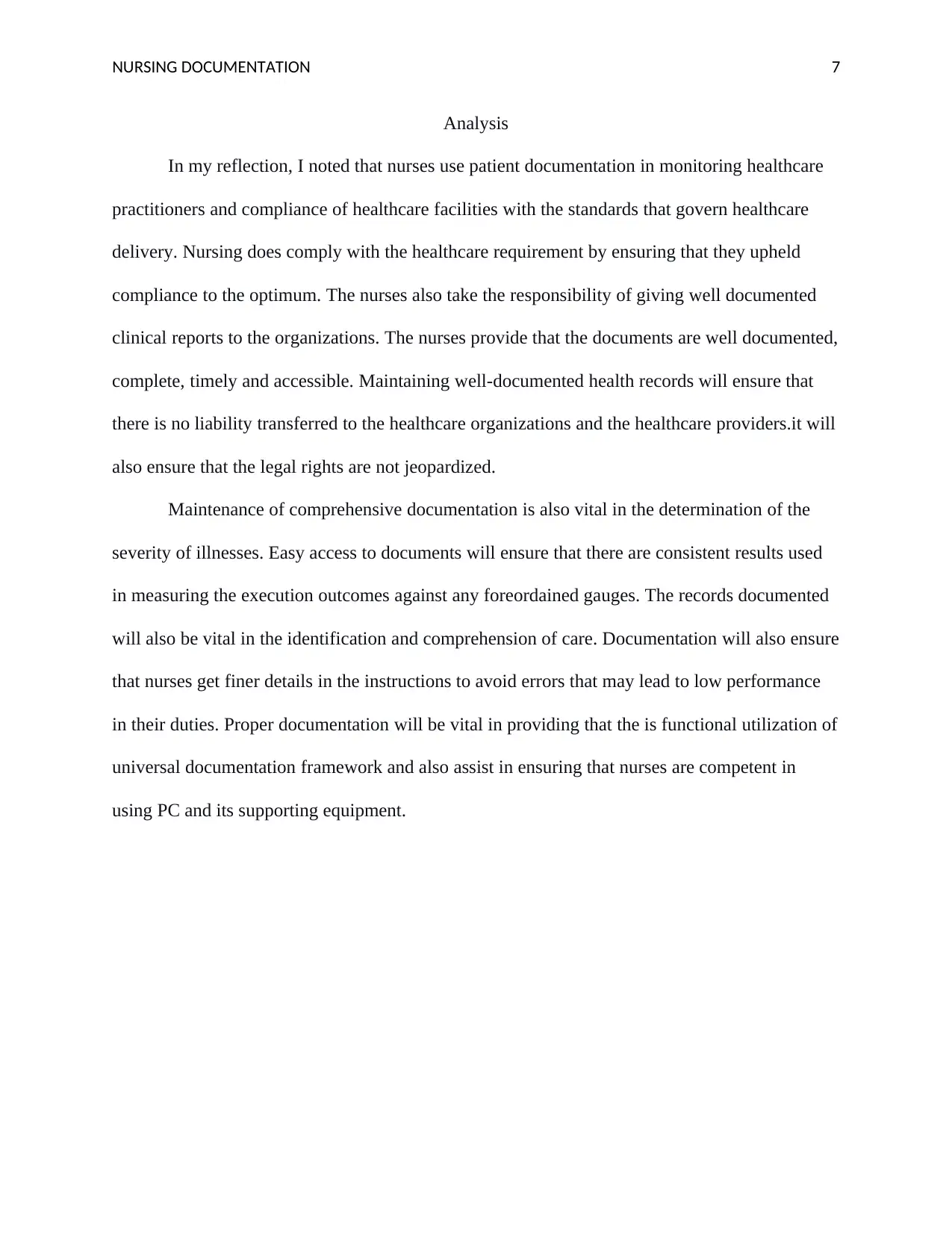
NURSING DOCUMENTATION 7
Analysis
In my reflection, I noted that nurses use patient documentation in monitoring healthcare
practitioners and compliance of healthcare facilities with the standards that govern healthcare
delivery. Nursing does comply with the healthcare requirement by ensuring that they upheld
compliance to the optimum. The nurses also take the responsibility of giving well documented
clinical reports to the organizations. The nurses provide that the documents are well documented,
complete, timely and accessible. Maintaining well-documented health records will ensure that
there is no liability transferred to the healthcare organizations and the healthcare providers.it will
also ensure that the legal rights are not jeopardized.
Maintenance of comprehensive documentation is also vital in the determination of the
severity of illnesses. Easy access to documents will ensure that there are consistent results used
in measuring the execution outcomes against any foreordained gauges. The records documented
will also be vital in the identification and comprehension of care. Documentation will also ensure
that nurses get finer details in the instructions to avoid errors that may lead to low performance
in their duties. Proper documentation will be vital in providing that the is functional utilization of
universal documentation framework and also assist in ensuring that nurses are competent in
using PC and its supporting equipment.
Analysis
In my reflection, I noted that nurses use patient documentation in monitoring healthcare
practitioners and compliance of healthcare facilities with the standards that govern healthcare
delivery. Nursing does comply with the healthcare requirement by ensuring that they upheld
compliance to the optimum. The nurses also take the responsibility of giving well documented
clinical reports to the organizations. The nurses provide that the documents are well documented,
complete, timely and accessible. Maintaining well-documented health records will ensure that
there is no liability transferred to the healthcare organizations and the healthcare providers.it will
also ensure that the legal rights are not jeopardized.
Maintenance of comprehensive documentation is also vital in the determination of the
severity of illnesses. Easy access to documents will ensure that there are consistent results used
in measuring the execution outcomes against any foreordained gauges. The records documented
will also be vital in the identification and comprehension of care. Documentation will also ensure
that nurses get finer details in the instructions to avoid errors that may lead to low performance
in their duties. Proper documentation will be vital in providing that the is functional utilization of
universal documentation framework and also assist in ensuring that nurses are competent in
using PC and its supporting equipment.
Paraphrase This Document
Need a fresh take? Get an instant paraphrase of this document with our AI Paraphraser
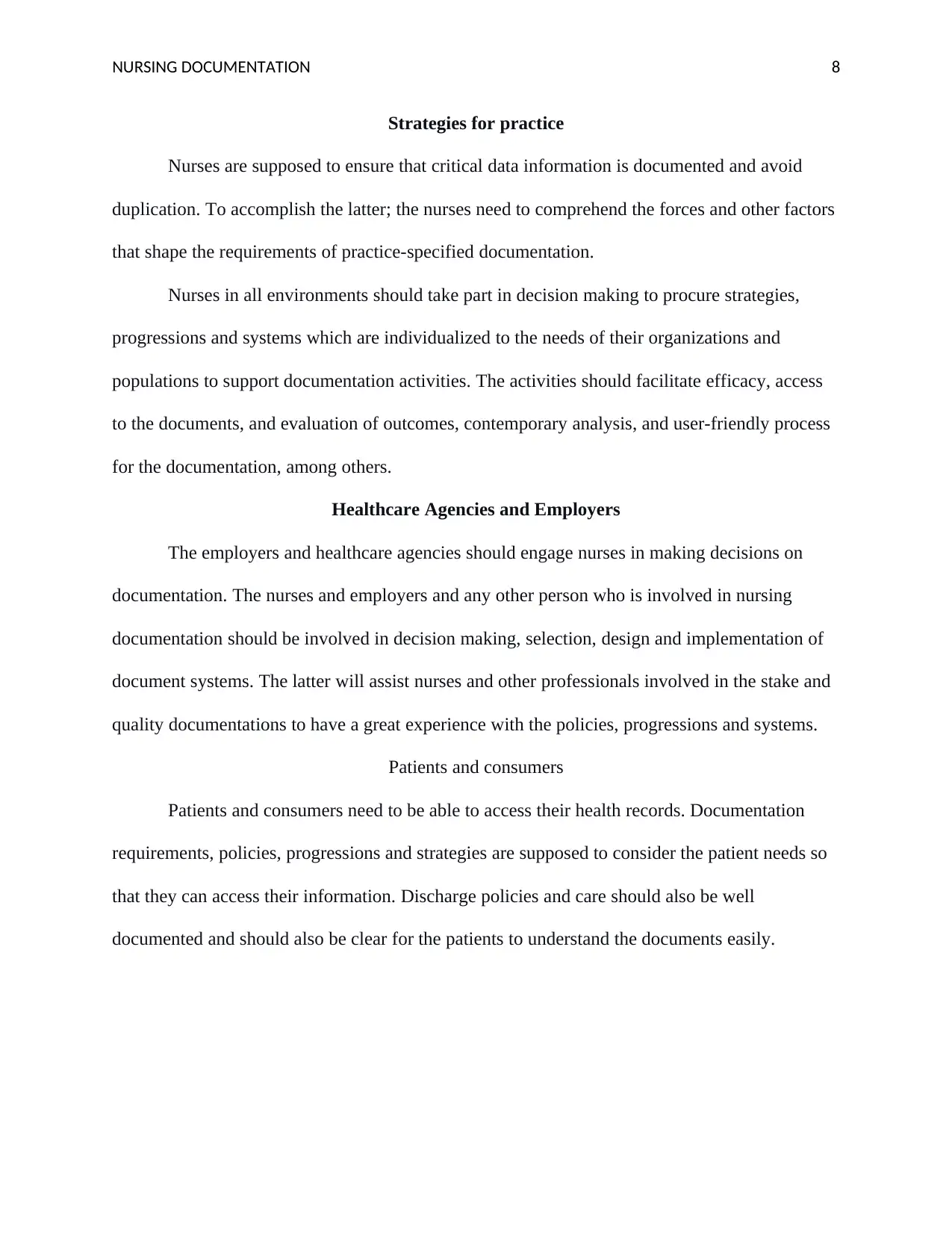
NURSING DOCUMENTATION 8
Strategies for practice
Nurses are supposed to ensure that critical data information is documented and avoid
duplication. To accomplish the latter; the nurses need to comprehend the forces and other factors
that shape the requirements of practice-specified documentation.
Nurses in all environments should take part in decision making to procure strategies,
progressions and systems which are individualized to the needs of their organizations and
populations to support documentation activities. The activities should facilitate efficacy, access
to the documents, and evaluation of outcomes, contemporary analysis, and user-friendly process
for the documentation, among others.
Healthcare Agencies and Employers
The employers and healthcare agencies should engage nurses in making decisions on
documentation. The nurses and employers and any other person who is involved in nursing
documentation should be involved in decision making, selection, design and implementation of
document systems. The latter will assist nurses and other professionals involved in the stake and
quality documentations to have a great experience with the policies, progressions and systems.
Patients and consumers
Patients and consumers need to be able to access their health records. Documentation
requirements, policies, progressions and strategies are supposed to consider the patient needs so
that they can access their information. Discharge policies and care should also be well
documented and should also be clear for the patients to understand the documents easily.
Strategies for practice
Nurses are supposed to ensure that critical data information is documented and avoid
duplication. To accomplish the latter; the nurses need to comprehend the forces and other factors
that shape the requirements of practice-specified documentation.
Nurses in all environments should take part in decision making to procure strategies,
progressions and systems which are individualized to the needs of their organizations and
populations to support documentation activities. The activities should facilitate efficacy, access
to the documents, and evaluation of outcomes, contemporary analysis, and user-friendly process
for the documentation, among others.
Healthcare Agencies and Employers
The employers and healthcare agencies should engage nurses in making decisions on
documentation. The nurses and employers and any other person who is involved in nursing
documentation should be involved in decision making, selection, design and implementation of
document systems. The latter will assist nurses and other professionals involved in the stake and
quality documentations to have a great experience with the policies, progressions and systems.
Patients and consumers
Patients and consumers need to be able to access their health records. Documentation
requirements, policies, progressions and strategies are supposed to consider the patient needs so
that they can access their information. Discharge policies and care should also be well
documented and should also be clear for the patients to understand the documents easily.
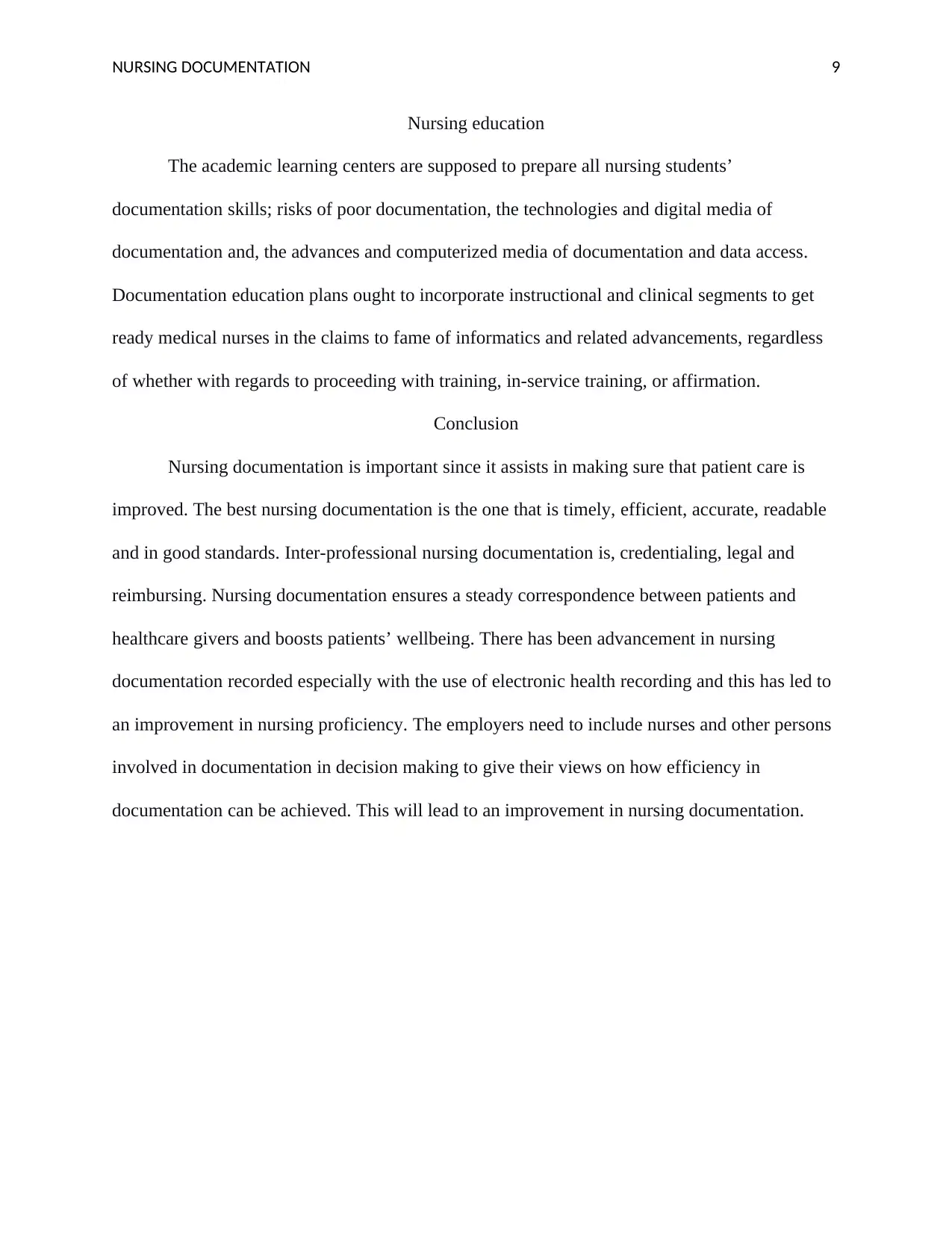
NURSING DOCUMENTATION 9
Nursing education
The academic learning centers are supposed to prepare all nursing students’
documentation skills; risks of poor documentation, the technologies and digital media of
documentation and, the advances and computerized media of documentation and data access.
Documentation education plans ought to incorporate instructional and clinical segments to get
ready medical nurses in the claims to fame of informatics and related advancements, regardless
of whether with regards to proceeding with training, in-service training, or affirmation.
Conclusion
Nursing documentation is important since it assists in making sure that patient care is
improved. The best nursing documentation is the one that is timely, efficient, accurate, readable
and in good standards. Inter-professional nursing documentation is, credentialing, legal and
reimbursing. Nursing documentation ensures a steady correspondence between patients and
healthcare givers and boosts patients’ wellbeing. There has been advancement in nursing
documentation recorded especially with the use of electronic health recording and this has led to
an improvement in nursing proficiency. The employers need to include nurses and other persons
involved in documentation in decision making to give their views on how efficiency in
documentation can be achieved. This will lead to an improvement in nursing documentation.
Nursing education
The academic learning centers are supposed to prepare all nursing students’
documentation skills; risks of poor documentation, the technologies and digital media of
documentation and, the advances and computerized media of documentation and data access.
Documentation education plans ought to incorporate instructional and clinical segments to get
ready medical nurses in the claims to fame of informatics and related advancements, regardless
of whether with regards to proceeding with training, in-service training, or affirmation.
Conclusion
Nursing documentation is important since it assists in making sure that patient care is
improved. The best nursing documentation is the one that is timely, efficient, accurate, readable
and in good standards. Inter-professional nursing documentation is, credentialing, legal and
reimbursing. Nursing documentation ensures a steady correspondence between patients and
healthcare givers and boosts patients’ wellbeing. There has been advancement in nursing
documentation recorded especially with the use of electronic health recording and this has led to
an improvement in nursing proficiency. The employers need to include nurses and other persons
involved in documentation in decision making to give their views on how efficiency in
documentation can be achieved. This will lead to an improvement in nursing documentation.
⊘ This is a preview!⊘
Do you want full access?
Subscribe today to unlock all pages.

Trusted by 1+ million students worldwide
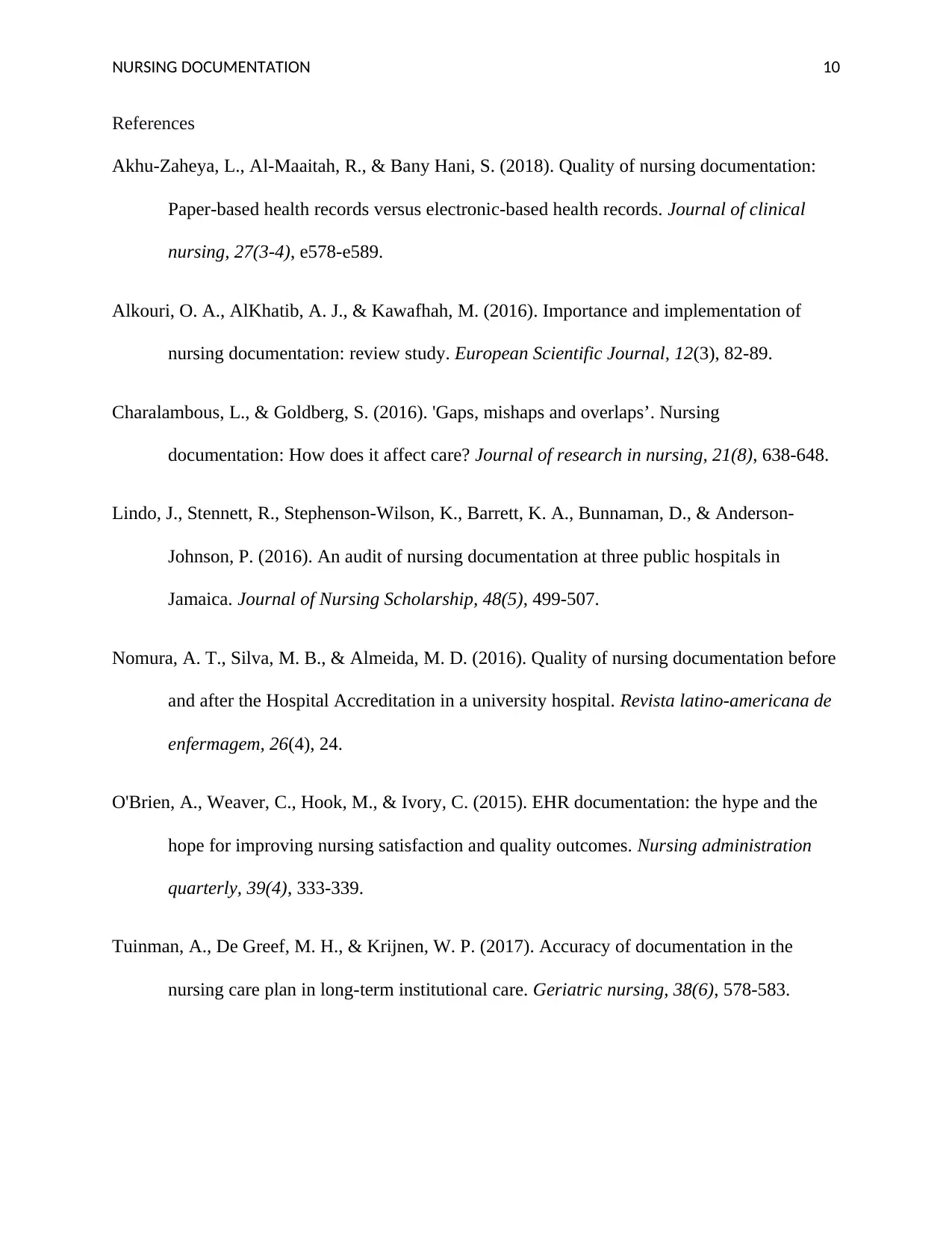
NURSING DOCUMENTATION 10
References
Akhu‐Zaheya, L., Al‐Maaitah, R., & Bany Hani, S. (2018). Quality of nursing documentation:
Paper‐based health records versus electronic‐based health records. Journal of clinical
nursing, 27(3-4), e578-e589.
Alkouri, O. A., AlKhatib, A. J., & Kawafhah, M. (2016). Importance and implementation of
nursing documentation: review study. European Scientific Journal, 12(3), 82-89.
Charalambous, L., & Goldberg, S. (2016). 'Gaps, mishaps and overlaps’. Nursing
documentation: How does it affect care? Journal of research in nursing, 21(8), 638-648.
Lindo, J., Stennett, R., Stephenson‐Wilson, K., Barrett, K. A., Bunnaman, D., & Anderson‐
Johnson, P. (2016). An audit of nursing documentation at three public hospitals in
Jamaica. Journal of Nursing Scholarship, 48(5), 499-507.
Nomura, A. T., Silva, M. B., & Almeida, M. D. (2016). Quality of nursing documentation before
and after the Hospital Accreditation in a university hospital. Revista latino-americana de
enfermagem, 26(4), 24.
O'Brien, A., Weaver, C., Hook, M., & Ivory, C. (2015). EHR documentation: the hype and the
hope for improving nursing satisfaction and quality outcomes. Nursing administration
quarterly, 39(4), 333-339.
Tuinman, A., De Greef, M. H., & Krijnen, W. P. (2017). Accuracy of documentation in the
nursing care plan in long-term institutional care. Geriatric nursing, 38(6), 578-583.
References
Akhu‐Zaheya, L., Al‐Maaitah, R., & Bany Hani, S. (2018). Quality of nursing documentation:
Paper‐based health records versus electronic‐based health records. Journal of clinical
nursing, 27(3-4), e578-e589.
Alkouri, O. A., AlKhatib, A. J., & Kawafhah, M. (2016). Importance and implementation of
nursing documentation: review study. European Scientific Journal, 12(3), 82-89.
Charalambous, L., & Goldberg, S. (2016). 'Gaps, mishaps and overlaps’. Nursing
documentation: How does it affect care? Journal of research in nursing, 21(8), 638-648.
Lindo, J., Stennett, R., Stephenson‐Wilson, K., Barrett, K. A., Bunnaman, D., & Anderson‐
Johnson, P. (2016). An audit of nursing documentation at three public hospitals in
Jamaica. Journal of Nursing Scholarship, 48(5), 499-507.
Nomura, A. T., Silva, M. B., & Almeida, M. D. (2016). Quality of nursing documentation before
and after the Hospital Accreditation in a university hospital. Revista latino-americana de
enfermagem, 26(4), 24.
O'Brien, A., Weaver, C., Hook, M., & Ivory, C. (2015). EHR documentation: the hype and the
hope for improving nursing satisfaction and quality outcomes. Nursing administration
quarterly, 39(4), 333-339.
Tuinman, A., De Greef, M. H., & Krijnen, W. P. (2017). Accuracy of documentation in the
nursing care plan in long-term institutional care. Geriatric nursing, 38(6), 578-583.
Paraphrase This Document
Need a fresh take? Get an instant paraphrase of this document with our AI Paraphraser
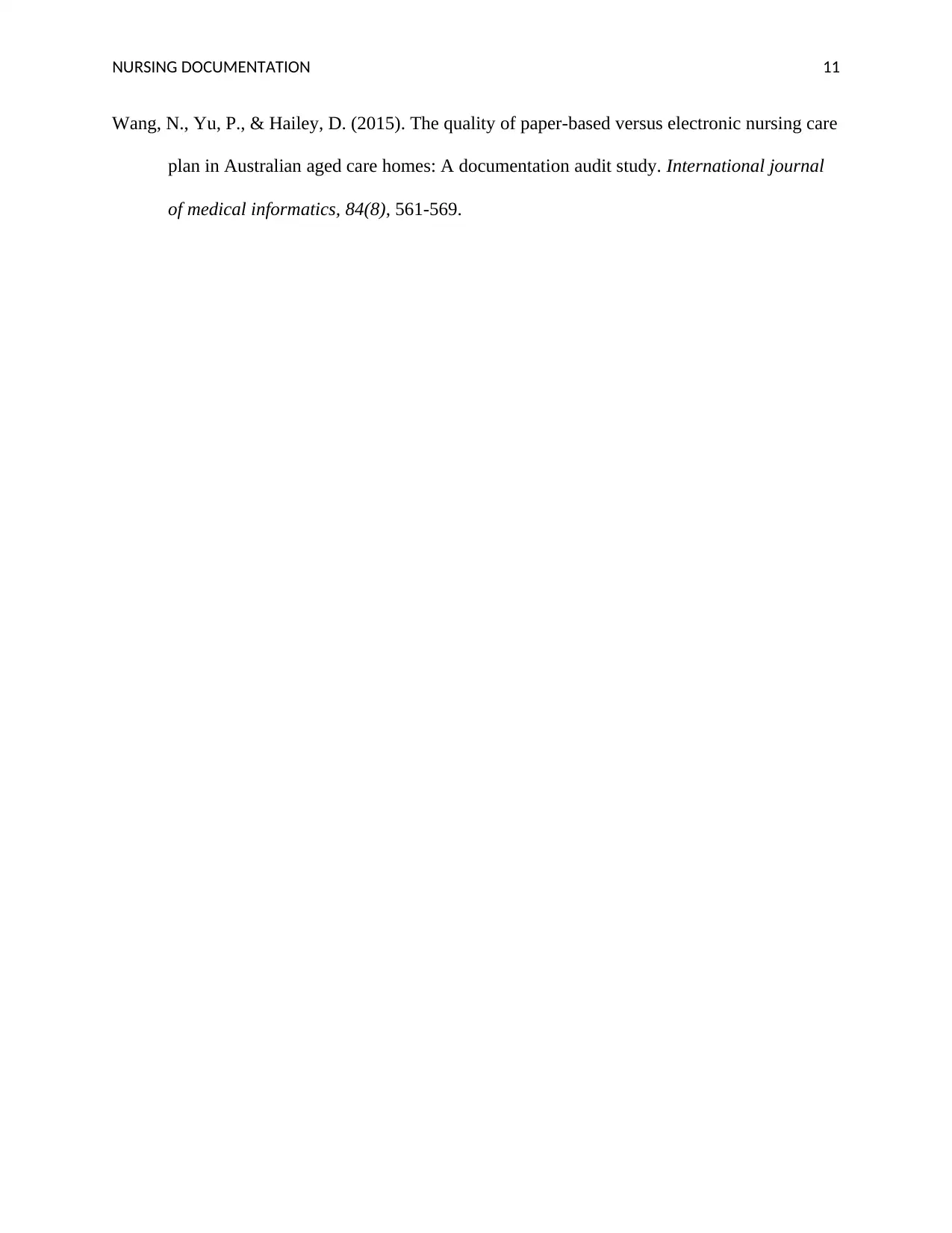
NURSING DOCUMENTATION 11
Wang, N., Yu, P., & Hailey, D. (2015). The quality of paper-based versus electronic nursing care
plan in Australian aged care homes: A documentation audit study. International journal
of medical informatics, 84(8), 561-569.
Wang, N., Yu, P., & Hailey, D. (2015). The quality of paper-based versus electronic nursing care
plan in Australian aged care homes: A documentation audit study. International journal
of medical informatics, 84(8), 561-569.
1 out of 11
Related Documents
Your All-in-One AI-Powered Toolkit for Academic Success.
+13062052269
info@desklib.com
Available 24*7 on WhatsApp / Email
![[object Object]](/_next/static/media/star-bottom.7253800d.svg)
Unlock your academic potential
Copyright © 2020–2025 A2Z Services. All Rights Reserved. Developed and managed by ZUCOL.





